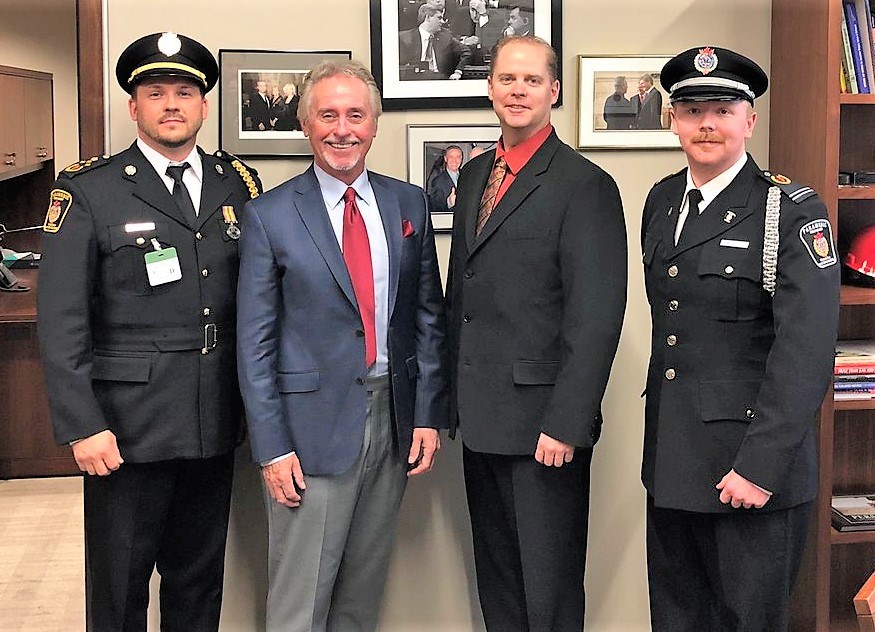Paramedics are trained to be calm and focused in all manner of life-or-death situations.
Speaking to politicians, however, isn’t one of those situations they were trained for.
Still, Moose Jaw and District EMS Chief Kyle Sereda brought his passion for his profession to Ottawa as he advocated on behalf of paramedics nationwide as part of the Paramedic Association of Canada’s annual Paramedics on the Hill trip.
“It was intimidating at first, but it was really good,” said Sereda who is also the provincial rep. on the Paramedic Association of Canada board. “We were really well-received. Paramedics are well-respected in public service, so the MPs were really receptive.”
Sereda met Tom Lukiwski, MP for Moose Jaw-Lake Centre-Lanigan and long-standing Liberal MP Ralph Goodale, who is the Minister of Public Safety and Emergency Preparedness. All told, Sereda met with a total of four MPs and a parliamentary secretary. The Paramedic Association of Canada had a total of 40 different meetings in total.
“When we do this, we pick a number of topics and focus on that,” Sereda said. “MPs are busy and so we keep our conversations around four different topics – some we’ve talked about in the past – and we just kind of re-highlight and see what has changed since the last time we talked to them. Some are new. So we tend to educate them on certain things that are happening in the paramedic world.”
The four topics that the paramedics wanted to highlight for MPs were: opioids, paramedic mental health and wellness, community paramedics and the Canadian Paramedic Memorial Foundation.
Being at the front line of the opioid crisis, the paramedics advocated that government meaningfully involve them in policy and program development. They also commended them for the additional funding of $30.5 million over five years in the 2019 budget.
“It’s a very big issue right across Canada, certainly all the way down to Moose Jaw,” Sereda said. “It’s here in Moose Jaw. For anyone who thinks it’s not, it is. While we don’t go to it as often as Regina, Saskatoon or Vancouver, it is still there and requires the same kind of approach to treatment.
“We wanted to remind the government that it’s still a problem – more so on the coasts and in the larger cities – but certainly here in Saskatchewan, it’s very much a problem as well.”
The Association also asked that the government support a national action plan for paramedics and organize a national paramedic mental health prevalence survey.
Monday, the Federal government unveiled an action plan on post-traumatic stress injuries (PTSI) among public safety personnel. The plan includes $20M for a National Research Consortium on PTSI and a $10M for a longitudinal study with the RCMP over the course of 15 years to track the effects of the job and how that works with post-traumatic stress injuries.
“It’s a great initiative and there are a lot of resources going into it,” Sereda said. “We wanted to make sure that this does not fall off the radar of any level of government because it does impact paramedics a lot. Paramedics are actually three times more likely than any other emergency service worker to experience the stresses of PTSI, suicides, compassion fatigue and all of those types of thing that are impactful in this job.”
The Association also advocated that the Federal government invest in community paramedic initiatives that could provide service to rural and remote communities, and to indigenous communities. Community paramedicine uses paramedics in non-traditional roles where they use their skills in areas like palliative care, hospital to home visits, wellness checks, home checks. The goal is to be more preventative as opposed to responsive.
“Community paramedicine is one that we’ve talked about for a few years now,” Sereda said. “It focuses around using existing paramedics and their scope of practice and skill levels beyond what they’re currently being used for.
“Paramedics would still be used in the same role as far as 9-1-1, but we’re available in some non-traditional roles.”
Finally, the Paramedic Association of Canada would like to see a national monument for fallen paramedics.
“That’s more of a direct conversation around funding as well as some land procurement in Ottawa,” Sereda said. “There are national monuments for police, fire and military for fallen members in the line of duty. We’ve had 48 since 1980. There is no national monument for paramedics.”
The Paramedic Association of Canada has raised $450,000 through its benevolent society after many years of fundraising for the project. The cost for the project would be $5 million and could be unveiled by 2022. The Association has submitted their official proposal to Canadian Heritage and Minister Goodale’s office.




